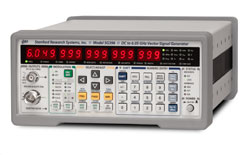
Stanford Research Systems has introduced the SG390 Series vector signal generators — high performance, affordable RF sources. Three new RF signal generators, with carrier frequencies from DC to 2.025, 4.050 and 6.075 GHz, support both analog and vector modulation. The instruments utilize a new RF synthesis technique which provides spur free outputs with low phase noise (–116 dBc/Hz at 1 GHz) and excellent frequency resolution (1 µHz at any frequency). Both analog modulation and vector baseband generators are included as standard features.
The instruments use an ovenized SC-cut oscillator as the standard time-base, providing a 100 fold improvement in the stability (and a 100 fold reduction in the in-close phase noise) compared to instruments which use a TCXO time-base.
The SG390 Series signal generators are based on a new frequency synthesis technique called rational approximation frequency synthesis (RAFS). RAFS uses small integer divisors in a conventional phase-locked loop (PLL) to synthesize a frequency that would be close to the desired frequency (typically within ±100 ppm) using the nominal PLL reference frequency. The PLL reference frequency is adjusted so that the PLL generates the exact frequency. Doing so provides a high phase comparison frequency (typically 25 MHz) yielding low phase noise while moving the PLL reference spurs far from the carrier where they can be easily removed. The end result is an agile RF source with low phase noise and essentially infinite frequency resolution, without the spurs of fractional-N synthesis or the cost of a YIG oscillator.
The generator has built-in support for the most common vector modulation schemes: ASK, QPSK, DQPSK, π/4 DQPSK, 8PSK, FSK, CPM, QAM (4 to 256), 8VSB, and 16VSB. It also includes built-in support for all the standard pulse shaping filters used in digital communications: raised cosine, root-raised cosine, Gaussian, rectangular, triangular and more. Lastly, it provides direct support for the controlled injection of additive white Gaussian noise (AWGN) into the signal path.
Stanford Research Systems Inc., Sunnyvale, CA
(408) 744-9040,
www.thinkSRS.com
info@thinkSRS.com
